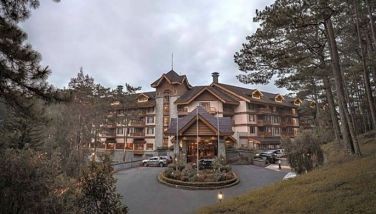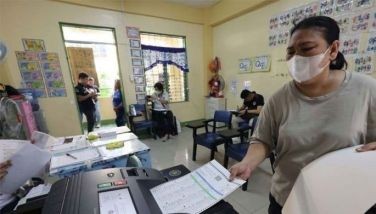EasyShare V570: Redefining our Kodak moment
June 6, 2006 | 12:00am
It began modestly enough – the technology of the camera – "as a light passing though a tiny hole in the wall of a dark room, with an upside down image projected on the opposite side of another wall."
This account of Encarta Encyclopedia of the beginnings of the camera is too archaic, too far back in time for present-day users of the camera to grasp, not with the ubiquitous camera phone with up to three megapixels of image powerloaded onto a device whose primary purpose is not even to capture images but to make voice calls.
What we consider old-fashioned today are the film-based, box-shaped cameras that capture snapshots of everyday life, which for a very long time had been the most important gadget around to preserve our "Kodak moments."
One can’t exactly blame George Eastman’s Kodak company for incorporating the word "Kodak" into everyday language. After all, it was Eastman Kodak that first introduced the earliest handheld cameras in the late 1800s and the first instamatic cameras in the early 1960s that made casual photography popular and within the reach of non-technical people.
The popularity of the brand itself in the Philippines had given way to expressions as "mag-kodakan tayo (let’s take pictures)," "nasaan ang kodak (where is the camera)?" "nagpa-kodak ka na ba (Have you had your picture taken)?"
The passing of time didn’t leave the Kodak camera unaffected by the march of technology. In fact, the Kodak digital camera today is the coming together of all things high-tech.
Since the days of the point-and-shoot cameras, the ordinary camera user has ceased computing shutter speeds, lens sizes, and apertures and distances, and light exposure to produce photographs. Automatic controls and default settings made it possible to capture objects, scenes, moments in a snap without having to bother with the computational aspect of photography. Digital cameras today function the same way and come in all forms and sizes – from the very basic to the state-of-the-art machines professional photographers use. But more often than not, the digital camera is a half-way choice between amateur and professional photography.
The Kodak EasyShare V570, for example, can be used as a basic camera for taking snapshots of everyday events or occasions or it can be used to learn the more intricate ways of more advanced photography.
For one, the V570 is a dual-lens camera – it has a fixed focal 23-mm lens on top and a more traditional 39-117 mm lens at the bottom, giving users the dual advantage of taking wide-angle shots and zoom capability in one camera.
In the tradition of the point-and-shoot technique, one only has to aim the camera to an object or scene and the subject appears on the 2.5" LCD screen, which serves as the viewfinder. Adjust the image for distance – zoom in or zoom out – and angle – pan to the left or right. When you press the shutter speed, the picture is taken, exactly as you’ve seen it on screen.
This is not all to it though to the Kodak EasyShare V570. Unlike traditional cameras, it gives the user more options for taking better shots, or for providing more depth and focus to your shots.
In the set-up menu, you can choose to shoot your photos in color, black and white or sepia for effect. Color shots can also be natural color, high color or low color depending on your objective.
There is such as a thing as an automatic digital red-eye reduction, blurry image detection to reduce errors in your shots and to adjust the camera accordingly.
The "burst" feature allows you to take four successive shots in a single press of the shutter speed. Put the camera in a flat surface or mount it in a tripod and you can activate the self-timer. The camera clicks, approximately 10 seconds after the shutter button is pressed. This is best if you are taking a group shot and you want to join the group photo or if you are waiting for a particular moment or scene to emerge.
While the V570 is on automatic mode, it also comes with 22 pre-configured settings to give users the best possible shots in a variety of settings. These settings include portrait, for full-frame photos; panorama, for wide-angled shots; sports, for action or motion shots; night portrait and night landscape, for taking pictures at night or in dark settings; self-portrait, for taking pictures of your self; fireworks, for taking shots of fireworks displays and for capturing their vivid and vibrant colors at nighttime; candle light, for taking shots at objects, people or scenes illumined only by candle light; sunset light, for taking those breathtaking sunset scenes; panning shot, for capturing a moving object such as an automobile or an airplane.
There is also a setting called the action, for taking photos of rowdy children; party, for taking pictures of people in motion and in alternating dark or bright settings; and backlight, which is ideal when light is behind a subject.
But perhaps, one of the most useful of these settings is one called "text." This is used when taking a snapshot of book or magazine page to capture texts, charts or pictures or to take photos of slide presentations as they are presented on a wide screen. This setting allows the camera to handle texts, colors and contours with greater detail such that when you print or view the photo later on a computer screen, the text, chart or frame comes out clear and readable.
The key to taking good shots then is to determine the correct setting for a desired shot. And because you are not using film, you can experiment with as many shots of a particular subject as you want and can switch to many different settings to explore angles and effects without worrying about the expense. If you don’t like a shot, you can easily delete it and start all over again.
At first, you won’t notice the difference of shots taken on different settings. But with time and practice and as you become familiar with the camera, you will begin to appreciate the feature combinations. Later, you can switch to manual mode and configure your own settings to give your shots a definite look and feel.
The V570 is also a video recorder. For variety, you can try recording five-, 10-, or 15-second actions. This gives you more options for making permanent important occasions or moments.
One of the advantages of going digital is that you have a variety of options on what to do with your pictures. According to studies, around 70 percent of shots taken from a digital camera are not printed. They are stored in PCs, Macs, notebook computers, USB drives or CD-ROMs for later viewing or sharing. They are transferred to a cellphone and sent to friends as MMS or used as wallpapers or screen display, sent to a blogsite or an online photo storage site, e-mailed to friends and relatives, uploaded to a personal webpage or blogsite or used as visuals in powerpoint presentations or flash animations.
Since the V570 box comes with an audio-visual cable, you can also view your photos and videos on your TV set.
On the camera itself, you have a choice to view your photos and videos by album or by date. Though you can’t downsize or edit the images on camera, you have the option to crop photographs.
Since the V570 comes equipped with software, you can later transfer the photos to your PC or laptop for editing and manipulation.
Printing photos need not be at a photo studio also. Digital cameras today come with portable printers so you can print your photos at home.
The Kodak EasyShare V570 is a high-resolution camera with up to five megapixels of imaging power and can print directly to a PictBridge-enabled printer.
At 5MP, you can print your still photos to up to 20 x 30 inches or 50 x 76 cm. However, you can also choose to shoot your pictures to 4.4MP, 3.1MP or 1.8MP for lower screen resolutions or smaller print sizes. For videos, the default size is 640x480 but you can also pare it down to 320 x 240.
The camera itself comes with a 32MB internal memory. However, this is not enough for a photo outing. We suggest that you purchase a 256MB or a 512MB memory card. This will give you enough memory to last a whole day of shooting.
The worst thing that can happen to you on a photo shoot, especially if you are recording a performance, is to run out of memory while the show is going on. At 32MB, the memory will go out sooner than you expected.
What we collect and choose to remember from snippets of our everyday lives is not defined by the camera we use. The digital camera is only a tool for extending the realities around us that we consider important. What was it that Susan Sontag said about photographs and the ethics of seeing? "...the most grandiose result of the photographic enterprise is to give us the sense that we can hold the world in our heads – as an anthology of images."
The shifting technology of the camera has changed our way of remembering via the photograph. In a sense, it has also somehow redefined our "Kodak moments."
This account of Encarta Encyclopedia of the beginnings of the camera is too archaic, too far back in time for present-day users of the camera to grasp, not with the ubiquitous camera phone with up to three megapixels of image powerloaded onto a device whose primary purpose is not even to capture images but to make voice calls.
What we consider old-fashioned today are the film-based, box-shaped cameras that capture snapshots of everyday life, which for a very long time had been the most important gadget around to preserve our "Kodak moments."
One can’t exactly blame George Eastman’s Kodak company for incorporating the word "Kodak" into everyday language. After all, it was Eastman Kodak that first introduced the earliest handheld cameras in the late 1800s and the first instamatic cameras in the early 1960s that made casual photography popular and within the reach of non-technical people.
The popularity of the brand itself in the Philippines had given way to expressions as "mag-kodakan tayo (let’s take pictures)," "nasaan ang kodak (where is the camera)?" "nagpa-kodak ka na ba (Have you had your picture taken)?"
The passing of time didn’t leave the Kodak camera unaffected by the march of technology. In fact, the Kodak digital camera today is the coming together of all things high-tech.
Since the days of the point-and-shoot cameras, the ordinary camera user has ceased computing shutter speeds, lens sizes, and apertures and distances, and light exposure to produce photographs. Automatic controls and default settings made it possible to capture objects, scenes, moments in a snap without having to bother with the computational aspect of photography. Digital cameras today function the same way and come in all forms and sizes – from the very basic to the state-of-the-art machines professional photographers use. But more often than not, the digital camera is a half-way choice between amateur and professional photography.
The Kodak EasyShare V570, for example, can be used as a basic camera for taking snapshots of everyday events or occasions or it can be used to learn the more intricate ways of more advanced photography.
For one, the V570 is a dual-lens camera – it has a fixed focal 23-mm lens on top and a more traditional 39-117 mm lens at the bottom, giving users the dual advantage of taking wide-angle shots and zoom capability in one camera.
This is not all to it though to the Kodak EasyShare V570. Unlike traditional cameras, it gives the user more options for taking better shots, or for providing more depth and focus to your shots.
In the set-up menu, you can choose to shoot your photos in color, black and white or sepia for effect. Color shots can also be natural color, high color or low color depending on your objective.
There is such as a thing as an automatic digital red-eye reduction, blurry image detection to reduce errors in your shots and to adjust the camera accordingly.
The "burst" feature allows you to take four successive shots in a single press of the shutter speed. Put the camera in a flat surface or mount it in a tripod and you can activate the self-timer. The camera clicks, approximately 10 seconds after the shutter button is pressed. This is best if you are taking a group shot and you want to join the group photo or if you are waiting for a particular moment or scene to emerge.
While the V570 is on automatic mode, it also comes with 22 pre-configured settings to give users the best possible shots in a variety of settings. These settings include portrait, for full-frame photos; panorama, for wide-angled shots; sports, for action or motion shots; night portrait and night landscape, for taking pictures at night or in dark settings; self-portrait, for taking pictures of your self; fireworks, for taking shots of fireworks displays and for capturing their vivid and vibrant colors at nighttime; candle light, for taking shots at objects, people or scenes illumined only by candle light; sunset light, for taking those breathtaking sunset scenes; panning shot, for capturing a moving object such as an automobile or an airplane.
There is also a setting called the action, for taking photos of rowdy children; party, for taking pictures of people in motion and in alternating dark or bright settings; and backlight, which is ideal when light is behind a subject.
But perhaps, one of the most useful of these settings is one called "text." This is used when taking a snapshot of book or magazine page to capture texts, charts or pictures or to take photos of slide presentations as they are presented on a wide screen. This setting allows the camera to handle texts, colors and contours with greater detail such that when you print or view the photo later on a computer screen, the text, chart or frame comes out clear and readable.
The key to taking good shots then is to determine the correct setting for a desired shot. And because you are not using film, you can experiment with as many shots of a particular subject as you want and can switch to many different settings to explore angles and effects without worrying about the expense. If you don’t like a shot, you can easily delete it and start all over again.
At first, you won’t notice the difference of shots taken on different settings. But with time and practice and as you become familiar with the camera, you will begin to appreciate the feature combinations. Later, you can switch to manual mode and configure your own settings to give your shots a definite look and feel.
The V570 is also a video recorder. For variety, you can try recording five-, 10-, or 15-second actions. This gives you more options for making permanent important occasions or moments.
Since the V570 box comes with an audio-visual cable, you can also view your photos and videos on your TV set.
On the camera itself, you have a choice to view your photos and videos by album or by date. Though you can’t downsize or edit the images on camera, you have the option to crop photographs.
Since the V570 comes equipped with software, you can later transfer the photos to your PC or laptop for editing and manipulation.
Printing photos need not be at a photo studio also. Digital cameras today come with portable printers so you can print your photos at home.
The Kodak EasyShare V570 is a high-resolution camera with up to five megapixels of imaging power and can print directly to a PictBridge-enabled printer.
At 5MP, you can print your still photos to up to 20 x 30 inches or 50 x 76 cm. However, you can also choose to shoot your pictures to 4.4MP, 3.1MP or 1.8MP for lower screen resolutions or smaller print sizes. For videos, the default size is 640x480 but you can also pare it down to 320 x 240.
The camera itself comes with a 32MB internal memory. However, this is not enough for a photo outing. We suggest that you purchase a 256MB or a 512MB memory card. This will give you enough memory to last a whole day of shooting.
The worst thing that can happen to you on a photo shoot, especially if you are recording a performance, is to run out of memory while the show is going on. At 32MB, the memory will go out sooner than you expected.
The shifting technology of the camera has changed our way of remembering via the photograph. In a sense, it has also somehow redefined our "Kodak moments."
BrandSpace Articles
<
>
- Latest
Latest
Latest
January 19, 2025 - 12:39pm
By Alex Pigman | January 19, 2025 - 12:39pm
January 19, 2025 - 10:05am
By Alex Pigman | January 19, 2025 - 10:05am
January 6, 2025 - 11:05pm
January 6, 2025 - 11:05pm
December 1, 2024 - 3:59pm
December 1, 2024 - 3:59pm
Recommended































